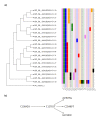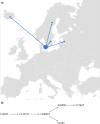SARS-CoV-2 transmission routes from genetic data: A Danish case study
- PMID: 33119657
- PMCID: PMC7595399
- DOI: 10.1371/journal.pone.0241405
SARS-CoV-2 transmission routes from genetic data: A Danish case study
Erratum in
-
Correction: SARS-CoV-2 transmission routes from genetic data: A Danish case study.PLoS One. 2021 Dec 21;16(12):e0261892. doi: 10.1371/journal.pone.0261892. eCollection 2021. PLoS One. 2021. PMID: 34932605 Free PMC article.
Abstract
Background: The first cases of COVID-19 caused by the SARS-CoV-2 virus were reported in China in December 2019. The disease has since spread globally. Many countries have instated measures to slow the spread of the virus. Information about the spread of the virus in a country can inform the gradual reopening of a country and help to avoid a second wave of infections. Our study focuses on Denmark, which is opening up when this study is performed (end-May 2020) after a lockdown in mid-March.
Methods: We perform a phylogenetic analysis of 742 publicly available Danish SARS-CoV-2 genome sequences and put them into context using sequences from other countries.
Results: Our findings are consistent with several introductions of the virus to Denmark from independent sources. We identify several chains of mutations that occurred in Denmark. In at least one case we find evidence that the virus spread from Denmark to other countries. A number of the mutations found in Denmark are non-synonymous, and in general there is a considerable variety of strains. The proportions of the most common haplotypes remain stable after lockdown.
Conclusion: Employing phylogenetic methods on Danish genome sequences of SARS-CoV-2, we exemplify how genetic data can be used to trace the introduction of a virus to a country. This provides alternative means for verifying existing assumptions. For example, our analysis supports the hypothesis that the virus was brought to Denmark by skiers returning from Ischgl. On the other hand, we identify transmission routes which suggest that Denmark was part of a network of countries among which the virus was being transmitted. This challenges the common narrative that Denmark only got infected from abroad. Our analysis concerning the ratio of haplotypes does not indicate that the major haplotypes appearing in Denmark have a different degree of virality.
Conflict of interest statement
The authors have declared that no competing interests exist.
Figures





References
-
- WHO. Coronavirus disease (COVID-19) Situation Report—116. Geneva, Switzerland: World Health Organization; 2020. Available from: https://www.who.int/docs/default-source/coronaviruse/situation-reports/2....
-
- Bernard Stoecklin S, Rolland P, Silue Y, Mailles A, Campese C, Simondon A, et al. First cases of coronavirus disease 2019 (COVID-19) in France: surveillance, investigations and control measures, January 2020. Euro Surveill. 2020;25(6):2000094 10.2807/1560-7917.ES.2020.25.6.2000094 - DOI - PMC - PubMed
-
- WHO. Coronavirus disease (COVID-19) Situation Report—11. Geneva, Switzerland: World Health Organization; 2020. Available from: https://www.who.int/docs/default-source/coronaviruse/situation-reports/2....
-
- WHO. Coronavirus disease (COVID-19) Situation Report—37. Geneva, Switzerland: World Health Organization; 2020. Available from: https://www.who.int/docs/default-source/coronaviruse/situation-reports/2....
Publication types
MeSH terms
LinkOut - more resources
Full Text Sources
Miscellaneous

